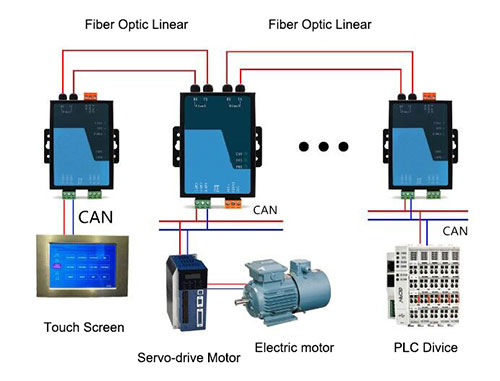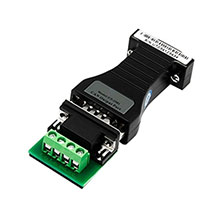CAN BUS Converter: Features & Working Principle
The CAN bus converter, also known as the CAN fiber optic converter, is a device that converts CAN bus signals into fiber optic signals, which are then parsed into CAN bus signals. In the process of transmitting data, it not only ensures the accuracy of information, but also works in pairs with CAN fiber optic repeaters to extend communication distance. The CAN bus converter has small size, powerful functions, fast transmission speed, and high reliability and safety. They play a crucial role in industrial control systems, automotive electronics, aerospace, and other applications, especially when long-distance, high noise anti-interference, and electrical isolation are required.
Working Principle
The principle of Can to fiber conversion is to use an optoelectronic converter to convert electrical signals on the Can bus into optical signals, which are then transmitted through optical fibers, and then converted back into electrical signals by the optoelectronic converter. This conversion method can effectively isolate electromagnetic interference and improve the stability and reliability of signal transmission.
The CAN bus requires the transmission of CAN bus data to optical fibers through a CAN fiber optic converter. Its model is simply as follows: CAN bus - fiber optic medium - CAN bus. In the CAN bus fiber optic system, the CAN bus signal is converted into an optical signal through a CAN fiber optic converter, and then transmitted through the fiber optic medium. At the terminal, the CAN fiber optic converter parses the CAN bus signal back to the corresponding receiving device. This is the principle of can bus transmitting data through optical fibers.
Features
- Long distance communication:
Fiber optic communication has excellent signal transmission performance and can transmit CAN bus signals over long distances, thereby supporting communication between dispersed locations. - High speed data transmission:

Some CAN bus converters support high-speed CAN communication standards, such as CAN FD (Flexible Data Rate), to meet the demand for higher data transmission rates. - Anti-noise interference:
Fiber optic transmission is not affected by electromagnetic interference, so it can effectively cope with electromagnetic interference and electrical noise, making the CAN bus signal more reliable. - Reliability and stability:
Due to the physical properties of fiber optic communication, CAN bus converter have high reliability and stability, and are not easily affected by temperature changes and environmental conditions. - Electrical isolation:
CAN bus converters typically have electrical isolation function, which can isolate electrical noise between buses and provide higher system stability and safety.
In short, the CAN bus converter is a useful device that can achieve long-distance and reliable transmission of CAN bus signals, and provide electrical isolation and anti-interference capabilities. When we encounter CAN relay projects that span thousands or even tens of kilometers, the CAN to fiber optic repeater is undoubtedly your first choice above all the communications cables and accessories. When selecting CAN bus converters suitable for specific applications, factors such as communication distance, data rate, electrical isolation requirements, and environmental conditions should be considered. It is worth noting that there is not only one category of CAN to fiber optic repeaters. Depending on the number of fiber optic interfaces, fiber optic connector types, and fiber optic cable types, they can be derived into more than ten sub categories. You should choose them according to your actual needs to better achieve your goals.

